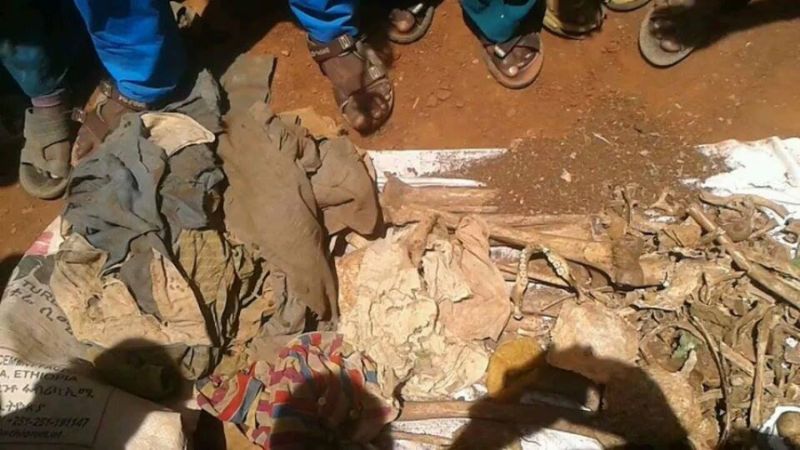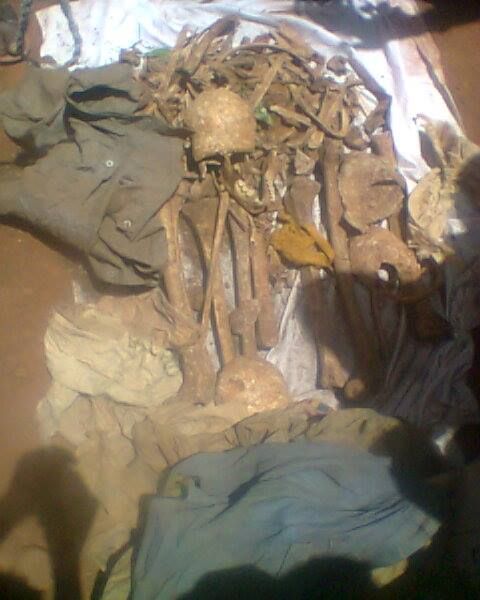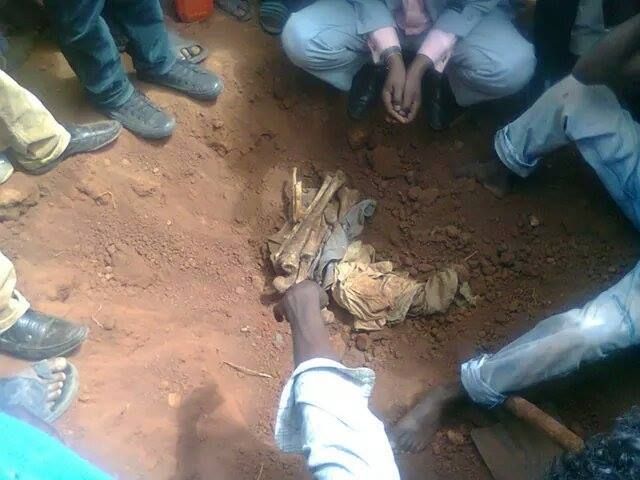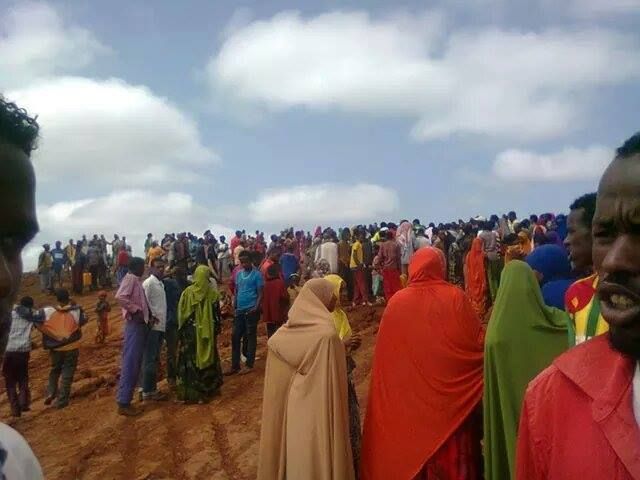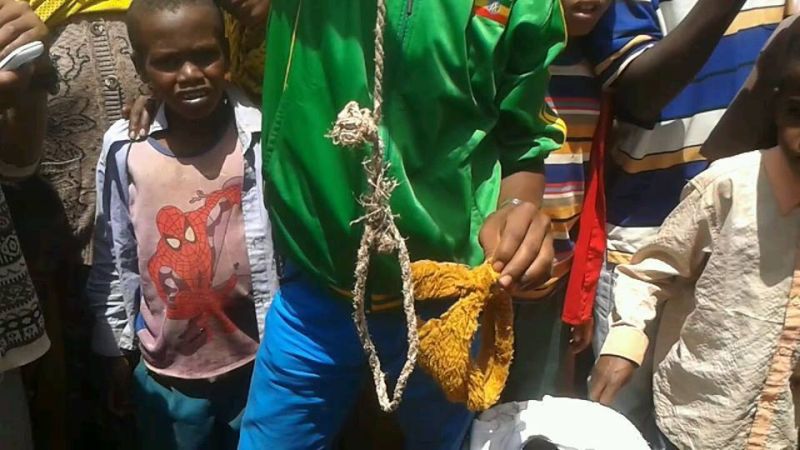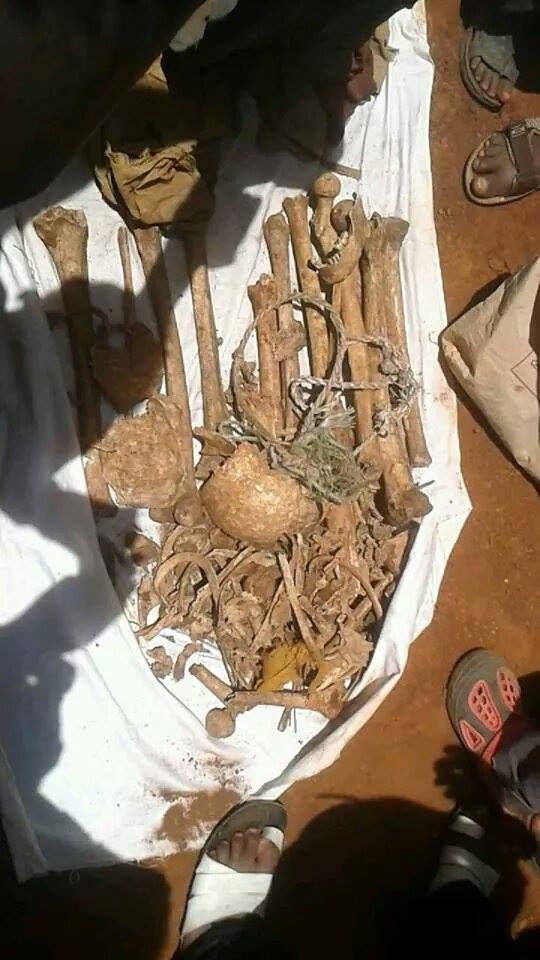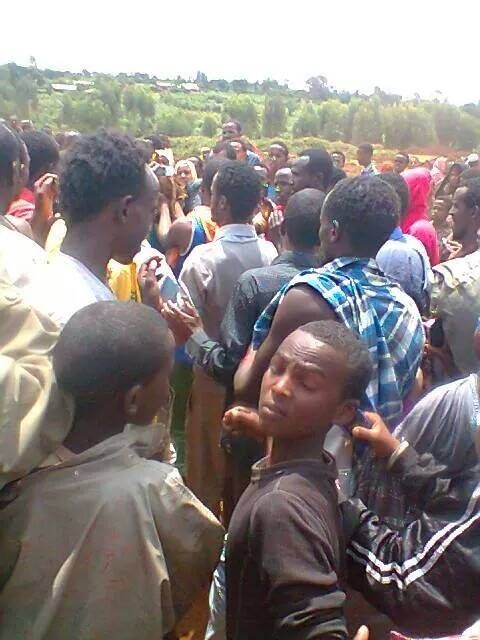By Waaqee Ji’oo Garbii | June 9, 2014
Background
First of all, my humble request to my reader is that my objective of using numerous sources from secular scholars and siting some verses from the Bible in this article is not to make any religion look good or bad when it comes to the Oromo struggle for freedom. Rather I am just convinced to write this article so that it can be read, discussed and counter attacked by anybody hoping that it will create more dynamism and openness in the Oromo struggle against injustice in Oromia. Indeed, I have at least two decades experiences of hearing the talk about ‘unity’ by the Habasha mainly among Christian community while they practically treat the Oromo as a second class citizen. Today, since the talk about Oromo ‘unity’ with the perpetrators became popular among some Oromo political and spiritual leaders more than the talk about unity among Oromo themselves which actually should have been given priority, I am persuaded to analyze and critically reflect on what ‘unity’ really means from ethical and theological perspective. Therefore, this article represents my opinion as an Oromo theologian who is addicted to promote peaceful revolution against any colonial system in Oromia, especially the Tigray People Liberation Front/TPLF’s human rights violation in Oromia and to advocate for the rights of the indigenous Oromo people. My arguments are against misunderstandings of the meaning of ‘unity’ that seemed to mislead thousands of Oromo and trucked them into the colonial net of Noe-Menelikites and Neo-Yohanesites.
The article is to create awareness to the Oromo on what unity with the colonizers is and is not for Oromo people. In doing so, it call the entire Oromo people in Oromia and around the world to vie for inviolable and unalienable human dignity and stand in unison and to continue demonstrating peacefully in opposition against the current brutal handed TPLF government has been conducting successive physical and psychological genocide, intolerable discrimination, violation of human rights, exploitation of human resources, natural resources, and political and economic deprivation of the indigenous Oromo people.
Yohannes IV had tried to divide Oromo people specially Oromo of Wallo to weaken their power since he faced determined resistance from them during his aggressive colonial expansion in the region. As the Abyssinians were afraid of Oromo and Muslim from the 16th, Yohannes IV mercilessly massacred thousands of Oromo of Wallo. He forced them to deny their religion, Islam, and forced for mass baptism as if they have no right to believe or not to believe. Oromo of Wallo stood together and confronted Yohannes IV with determined resistance. They were given only two chances: either to be baptized to follow EOC or to be killed. Many rejected and were subjected to death (Caulk 1972, De Salviac 1901). According to Dhibbisaa Hirphaa, Yohannes IV was convinced that Oromo of Wallo were so united and not easily detached to fight for their identity and country, as a result he changed his tactic. He announced a new decree that all converted Christians have to wear three colored thread as a necklace to be identified from Oromo Muslims. If anyone did not wear this thread necklace, he declared that the Christians should not great them, give them idea or information, or go to their homes to socialize: to drink coffee, to eat food. These hindered the Oromo of Wollo from sharing information and encouraging each other to continue fighting for their freedom; finally their power became weaken, and they failed in the brutal hand of Yohannes IV of Tigray (Dhibbisaa Hirphaa 2008, interview on September 20).
The Neo-Yohannesites, what I mean are TPLF who has been exhuatvily working to divide Oromo people by the name of christianity are striving to renew this dreadful act. Oromo people still have unhealed scar of what Yohannes IV has done against them, but the Tigrians celebrate him as their hero every year. How is it possible to be united and remain as Ethiopian for Oromo people while the Habashas are still singing for the man who committed genocide? The Neo-Yohannesites- the Tigrians still lead Oromo at gun point, and they still extremely exploit Oromia. The on going extra judicial killings, torture, imprisonment and unacceptable intimidation against humanity by this brutal government in Oromia proves this.
Between 1886 and 1887, Menelik II evicted Oromo people from their own land and he built Addis Ababa as his capital city (Pankhurst 1977). He did not only remove the Oromo from Finfinnee – the colony name Addis Ababa- but also he enslaved and forced them to pay tax and to guarantee food security for settlers including his soldiers (Benti 2001). Menelik II brought the settlers from Abyssinia (Falaasaa 1999). The vast portion of Addis Ababa was owned by thirty one of Ethiopian officials (Pankhurst 1985) and army officers while the owner of the land, Oromo, were marginalized and became laborers (Benti 2001). October 27, 1907 declaration assured the permissibility of selling and buying Oromo land by the Ethiopian officers and the foreign landlords (Garretson 1974). The indigenous people were obliged to work as gabbars (serfs) on their own farm land which was given to the naftnya (gun carrier, settler) who participated in the conquest of the Oromo country and to the clergy of the EOC (Tolla 2003). “The EOC provide a theological legitimation of the Empire and the Amhara claim to primacy in the central-periphery structure of political power” (Eide Oyvind M 2000, 21). This church has a strong political-governmental support when it comes to land grabbing in Oromia still today. Finfinnee being the heart of Oromia remained as an Abyssinian political center and under colonial rule. Today it has become the place where thousands of Oromo nationalists are suffering in prison for no apparent crime against humanity or any Waaqayyoo’s creation than fighting political and economic injustice that reigned over Oromia.
One of the things that make the process of Oromo unity with perpetrators very long and impossible is the insolent attitude of the perpetrators who persist to deny the wrong done in the past. For example, according to the Amharic bi-monthly magazine Lomi, criticized in one of its publications, Obbo Bulchaa Dammaqsaa even for saying that the Amharas should ask the Oromos for forgiveness about the wrongs done to the Oromo. According to the magazine, it is foolish to ask the Oromos for forgiveness, because the wrongs done to the Oromo people was done, not only by the Amharas, but by the Oromos such as Ras Gobaanaa Daacii and others, who were in power at that time with Menelik II: even Obbo Bulchaa Dammmaqsaa, who was one of the ministers during the reign of Haile Selassie are equally to blame. It is insolent on the side of the Neo-Menelikites for whom Menelik II continues to be the hero, to praise him for what he did. He waged a war which resulted in the massacre of about five million Oromos when he built his empire. He is their hero of harma muraa (mutilation ofbreasts) and harka muraa (mutilation of the hands) at Anoolee. For the victims of his barbaric and inhuman deeds Menelik II is seen as a never forgotten enemy. The mindset of the devotees of Menelik II and his atrocities on Oromo are the two sides of the same coin. Menelik II and his evil deeds are their cherished history and heritage.
People often strive to force the word say what they want it to say than the true meaning it intended to give. For example, the word ‘unity’ is frequently heard in our community; nonetheless, it is given a wrong interpretation from the way it should be. It is essential to investigate what unity is and what it is not. I have been asking myself this question because of the common trend in Oromo society and the socio-political, economic, and ecumenical instruction Oromo do with non-Oromo whether in Diaspora or in Oromia. The ‘unity’ should not be the one which fits to the size of personal ego or not the one in which certain group will enjoy opportunity on unbalanced judgment at the risk of others. For instance, the Bible portrays nowhere that Christians should accept such unity. It should be verified according to the word of God. One thing we need to know is that, unity cannot be made or declared without thorough argumentation, dialogue, without deep rooted Biblical orientation and scientific reasoning, repentance from wrongs done in the past and reconciliation. If not, the unity will remain with wounding friction.
Unity should be understood in the context of diversity. One individual is a person who is made of one cell in the womb of his/ her mother, who later developed into a living being with millions of cells. As an individual the person is only one person, but he/she has parts of the body with various functions. The apostle Paul used the illustration from the parts of the body for the unity of believers as one body of Christ, with the diversities of spiritual gifts and each of them is helpful for the proper functioning of the Church of God, the one is not better than the other. So believers should stay in unity and in love without one group boasting over the others. So every part should be recognized and respected. That is how unity continues whether it is the unity of the body or the society (1 Corinthians 12-14).
If development or growth continues, the diversity will continue, but that should not be seen as a threat to the unity, as long as the growth is proportional. This can be true for the individual person, the society, and the organization. But the growth should be proportional in order to keep the unity in place. Biology calls a disproportional growth an acromegalic growth. It is a disorder caused by excessive secretion of the pituitary gland and is marked by progressive enlargement of hands, feet, face, etc. (Webster’s New Encyclopedic Dictionary, 1993, 10). We can easily see that there is such a disproportionate growth in Ethiopia which is a menace to unity. One group grows, the other group stands and gets milked like a cow. Most of the resources Ethiopia uses come from Oromia, but there are not even enough asphalt roads in the state of Oromia. The World Bank economist, Adugna stated that the poverty in Oromia is unacceptably going high. While paying more taxes, Oromia’s population has the worst access to health care. This is due to biased budget allocation of the ruling party, TPLF against Oromo people. Comparing child mortality rate in Oromia with that of in Tigray, it is at worst level in Oromia. Equal right and equal opportunity in public services in Oromia are poorer than other regional states under TPLF regime (Adugna 2006, 7-15).
Other scholars like Tonvoll, Sethi, and Shinn, and Vaughn argue that political persecution has resulted in tremendous brain drain as large number of professionals including engineers, lawyers, medical doctors, and are forced to leave Ethiopia. They stated that Ethiopia is on the front line in losing highly trained professionals in Africa (Vaughn & Tonvoll 2003, Sethi 2000, Shinn 2004). This is the result of human rights violation. Thus, Human Rights Watch (HRW) reported that human rights violation in Ethiopia is very challenging issue in East Africa (HRW 2010). The Oromo sociologist Mekuria Bulcha has argued that “non-Tigrayan people in Ethiopia are deeply dissatisfied by the present government…the Oromo seem to be in dilemma: their citizenship rights are not protected by the constitution and they cannot use the constitution to opt out, the only option they have to protect their rights is taking up arms.” (Mekuria 2011, 608-609). A study conducted by Edmond Keller shows that about 72 per cent of Oromo are not satisfied with policy of TPLF, 80 per cent are dissatisfied with health care of the ruling party, 82 per cent are not satisfied with the resource distribution for road facility and 84 per cent of the Oromo participants in the study are dissatisfied with judiciary system – court under the government. Keller vividly concluded that about eighty per cent of Oromo people are dissatisfied with the TPLF government (Keller 2005).
The Oromo who continue to speak about unity with colonizers in such a situation should think at least better than a cow that continues to get milked but is not given any food in return for the milk she gives; a cow that continues to lick the head of the one who milks her as a sign of love and submission. Nobody hates unity when unity goes with proportional growth and respect. If there is any development in Oromia, it is in accordance with TPLF’s needs, it is not for the oppressed people. TPLF is illegitimate ruling party in Oromia since it continued to persecute, torch, and kill Oromo nationalists. As mentioned above, it is known that all Ethiopians are one or at least they are of mixed blood. Even the Habashas, who consider themselves as pure Semitic people even more than the Arabs are semitized Cushitic people according Mordechai Abir (see above). After all, the Bible says that the whole humanity came from Adam. Modern science also seems to confirm that, when it says that Ethiopia was the origin of human beings. So unity should be seen in its proper context. The Oromo never hated unity. They accepted with big respect other ethnic groups made them their own and embraced them and treated them as their equals Oromo always. However, all this things will not hinder Oromo people to establish their independent state as Oromo forced to be part of Ethiopia by colonial power and by the Western powers in 1890s. What Oromo hates is slavery that is TPLF’s domination over human and natural resource in Oromia. The Oromo are tired of being led at gun point.
So, Oromo people as the whole like ‘unity’ whether Waaqeffataa, Muslim or Christian among themselves in Oromia and with neighboring counties. Nonetheless they need to understand ‘unity’ in very specific ways for it to be acceptable and adequate. Understanding it in a specific ways, Oromo can come to see that they are thinking about the meaning and role of unity in a just and true reconciliation. Therefore, the unity Oromo need is not only as Christians but also as Oromo in general, and it should be one that is by free from atrocity, misrepresentation, acrimony, maliciousness, and malevolence. The following three points will define and discuss unity with genuine reason and relatively verified truth.
1. Unity is not all-encompassing
Unity is not a forced unity rather it is a unity in freedom that people can decide to show their willingness to live together in the future or for different future. It does not mean that the strong will have political power to exploit the weak and force the oppressed to remain under the brutal hands of the oppressors. The Apartheid regime in South Africa has been exploiting the natural resources and human resources of the black people by force as well as by using some dynamic Christians who got some privileges and gave closed eyes and closed ears for the cry of their own people. Apartheid and its collaborative classes perpetuated classism. As I have mentioned above, some theologians in South Africa tried to legitimize injustice made by the regime and persuade ordinary women and men to accept Apartheid. Thus this article argues that the Apolitical Oromo Christians (Oromo Christians who try to stay away from Oromo politics) whether ordinary believers or theologians need to learn from the history of South Africa. Additionally, the work is to alarm Oromo people so that they will reject any sort of preaching that attempts to pursue them to accept oppression. Theologically, we are united with all Christians who accepted Jesus Christ as their personal savor irrespective of all their color, citizenship, ethnic, class, clan, geographical location. True unity is a “…unity that develops oneness in thinking, feeling, willing, and acting. That is true solidarity and cohesion.” (Hoyland 2008, 104).
2. Unity is not uniformity
The unity that the Bible teaches is not the unity of sameness in language, culture, and nationality on earth. True unity is in differences. God the Father, God the Son and God the Holy Spirit is different but one. Though it is often overlooked, unity does not mean that we hand over our Christian values in any condition or we sacrifice their unique interest as Oromo as the whole. It is true that true unity can maximize the alterations we have as human beings, yet it does not downplay differences. It instead endeavors to bring every value, perspective, tolerance, and recognition to boost the unity because it is believed that everyone is needed, and there should be affirmative action for the maltreated. The unity the Oromo need is the one that carries with it practical attitudes and love in actions, to accept one another and to care for one another.
It is illogical in any society to preach and to urge the mistreated, exploited, and marginalized people to establish unity with those whose fingers are on the button of their weapon to hunt down when the oppressed claim their God given rights or fundamental human rights. Rather it is incredibly important to bring the oppressed from the margin so that they can establish their presence, air their voices, restore their human dignity, and advocate their life (Luke 4:16-20). As Christ’s representatives, Christ who proclaimed freedom to the oppressed, apolitical Oromo Christians do not need to defend status quo to carry the name ‘Christian’ and move around. Rather I urge them to be involved not to avenge or destroy the oppressors but to expose their evil deeds. It is also their duty to acknowledge the suffering of Oromo people in the hand of the Ethiopian rulers, to give hope and encourage the oppressed that the day of freedom is at hand and to work on to realize this truth. This is the way truth can be established- both the wronged sufferer and the wrong doers will establish a common or shared identity for different future.
3. Unity is not mere juxtaposition
Unity does not mean that we are keeping others’ interests controlling our interests. Theologically, unity is simply measured by how fellow humans are relating to one another based on his/her free-will. Unity is achieved based on genuineness and self-respect. Indeed, unity is not established for the sake of personal gain while damaging others. It is like a fair ground that two parties establish and keep it alive. Those who come to unity have something either to gain or lose in order to have this fair ground, based on established truth.
One of the major obstacles to a real unity and lasting coexistence in Oromo society whether in secular or in the Church is that some of our leaders are unwilling to accept anything less than ideological domination over their fellow brothers and sisters. Actually, this depraved understanding of unity is, even, one destructive philosophy the non-Oromo have been striving and are striving to impose on Oromo people. It is not a taboo to say that the political leaders of the Ethiopia Empire need all human and natural resources in Oromia but they do not like the indigenous people like the owner of the cow who likes the milk, but not the cow. Even if he likes, they are not on the same level, they are a human being and a cow. This is not unity at all. Thus many Oromo elites, farmers, university students, Oromo business men and women and every concerned Oromo are claiming equal rights and opportunities in independent state.
During the overwhelming civil rights movement which was led by the man of God, Martin Luther King in the USA similar story was happening against the black people: “how to remain committed to the equality enshrined in the constitution and teachings of Christianity, yet maintain white superiority and control…” (Gruchy 1995, 137). Thus I dare to claim that there is not only a false unity but there is also false separation. False separation is a separation with wrong reasons: differing standards, personal disagreements and others. Unity and separation should be kept in balance because unity is not something we preach or dare to have just to keep our reputation or just because people around us sing for it. It should be tested by the word of God, and our pats and experiences.
For unity to be a unity, it must be rooted in objective reality as well as subjective perspectives that make unity for all times and all places. Otherwise unity will be unsuccessful. Then, what is the source of Christian unity? What is the nature of Christian unity? To answer these questions, I think the Bible has to be read and heard as is the living word of God for Christian’s whole life. Indeed, it has to be also interpreted in the real situation in the society.
The Bible teaches us that Christian unity is in the triune God (God the Father, God the Son and God the Holy Spirit). This unity is exceedingly a precious gift from the triune God in whom unity is reality and mandate. It surpasses ethnic boundaries, nationality, sex, age, color and the like. John Douglas Hall has described unity of the Church in the unity of the Triune God (Hall, Douglas Jon 1996, 72-73). The triune God who created us in His image united us with all humankind. It is very important to examine our perception to other people, for Christians are not called to separate people into ‘we’ versus ‘other’ or ‘us’ versus ‘them’. We are connected to all people (Rom 5:12, 18; 1 Cor. 15: 21-22). Nevertheless, our oneness in Christ should not be misused either to abuse other and to exploit them or to be submissive to those who go beyond their limitations to abuse us (Luke 6: 31).
Having in mind what has been said above, I am convinced that it is very important to explore the source of Christian unity based on the Bible, especially the Gospel of John in the New Testament. Jesus’ prayer for his followers saying; “My prayer is not for them alone. I pray also for those who will believe in me through their message, that all of them may be one, Father, just as you are in me and I am in you. May they also be in us so that the world may believe that you have sent me. “(John 17:20-21, NIV, italics added). This prayer for unity can be seen in the light ecumenical concept, that is, Oromo Christians ‘unity with all Christians around the globe. It is this concept that unites all Christians from local ecumenical partnerships to inter-church relations at the national to international level. As I have said before, the scope of this unity surpasses ethnic boundaries, color, age, class and whatsoever we call. It is very universal. The prayer of Jesus, “that they may be one” does not encumber or impede Oromo Christians from participating in Oromo national struggle.
The source of Christian unity is Jesus Christ, God the Son. He is the one who died for mankind to save them from their sins (John 11:52). Jesus is the Good shepherd who admits His sheep- those who accepted Him to the fold of heavenly membership (John 10:1-18). Jesus metaphorically taught that He is the vine and believers are His branches (John 15:1-11). This shows a possible stronger idea of Christian incorporation in Him. Paul in his letter to Roman reinterpreted this metaphor when he explains that believers are body of Jesus Christ and united in Him (Rom 6:1ff, 12:4-5; 1cor 12:12-31; Col 3:3, Eph 1:23, 4: 15-16).
The source of Christians’ unity is God the Father. Jesus prayed that Christians may share and experience the union that exists between the Son and the Father (John 17:21-22). When He prayed this prayer, Jesus was on this earth. Still they are united with God the Father. This relatively, indicates that Jesus’ concern of Christians’ unity is not bound or limited by having one language, one culture and one country. The unity that exists between the Godhead is the invaluable and only source for the unity between believers and Godhead as well as the unity between believers and other Christians (John 1:14, 2:11, 12:22-33, 15:13, 17: 24).
The source of Christian unity is the God the Holy Spirit (John 14: 25-26, 15:26, 16: 5-15). In his letter to Ephesians Paul states that all Christians are one body of Christ as they have one Spirit- God the Spirit, one hope, one faith, one Lord, one baptism, one God the Father of all (Eph 4:4-6). It is in this way that all believers are privileged and obliged to live in spiritual unity with other believers. This unity extends even to those with who Christians have no physical or actual collaboration. Therefore, the existence of separate congregations, many languages, visible churches or organizations locally, nationally and internationally does not constitute a challenge to unity. Because Christian unity has got its source from the triune God and it is essentially spiritual in nature.
The nature of Christian unity is very important thing to know for Oromo people as a whole, especially, for apoliticalOromo Christians. It is crucial to understand Jesus’ teaching to explore the nature of Christian unity. The Lord Jesus Christ summarized the idea of this nature of Christian unity in the Gospel of John (John17:20-23). These verses give a clue that Christian unity is a unity of love. For example, John 13:34-35, 15:12 assert more explanation of the previous verses in terms of “loving one another”. Theologically, this love is astonishing, it is what initiated and moved God the Father to send His begotten Son to save the world (John 3:16). Equally, the mutual unity and love of God the Son with God the Father caused the Son to show the extent of His love and unity through His death on the cross and laid down His life to those who respond by faith to what He did on the cross ( John 13:2, 15:13).
The nature of this unity is a loyalty to the Lord Jesus as He is the Lord, liberator and advocate of the believers (John chapters 15 and 17). John chapter 15 illustrates that the branches are primarily joined and attached to the stem, and only indirectly attached to each other. Hence, believers’ unity as a body of Christ is obviously dependent on their individual dependence on Jesus.
The indwelling of God the Father and the Son through God the Holy Spirit in believers also shows believers life of fellowship / unity that surpasses color, clan, class, ethnic, language and culture (John 14:10-11,20, 17:20-23, 27). So it is more heavenly unity that modeled nature of Christians’ unity. What was explored so far about the source and nature of unity is not abandoning Christians to be individualistic. By no means! Rather it attempts to give better a better social and theological understanding of unity in political framework. Fellowshipis also another nature of unity in the Gospel of John (John chapter 17). The two big images of flock and vine that run throughout the gospel of John can summarize the partial part of the unity the New Testament teaches. John indicates Jesus’ concern not only for individuals but also for group of people, unbelievers (John 11: 49-52). Of course, the nature of Christian fellowship is not confined to a human formulated idea. It is very universal fellowship that one can enjoy with the entire community of believers beyond language, culture, age, color, citizenship and the like. This indicates the sources and nature of Christian unity is unique. Unquestionably, unity in biblical concept does not hamper Oromo Christians’ participation in Oromo national struggle, and therefore apolitical Oromo Christians are urged to reexamine whether their claim “Christian participation in politics disunites us” is biblical, historical, and practicable or not.
In short, until the day Abyssinians can accept an Oromo citizen as a fellow human being, admit the genocide they waged against millions of Oromo, recognize independent Oromia which is currently under their colony, stop hating and dehumanizing the Oromo in the Ethiopian empire, and accept Oromo individual beauty, it is idiotic or ridiculous to talk about unity between the Oromo and Abyssinians. God called us to resolve this problem.
Truth is a desire or willingness to the acknowledgment of wrong. It is a fight for validation of excruciating loss and past experiences. Truth is, indeed, not without mercy. Mercy is the image of compassion, forgiveness, acceptance, restoration, healing and a new start either to common or different futures. Justice raises powerful images of making things right. It creates equal opportunity, rectifies the wrong. Peace brings the image of harmony, unity, security and well-being. Forgiveness is a battle on which one must win out over the other. It is the process through which parties validate the truth. Reconciliation is a locus where people and other things come together. It focuses on the validation of both truth and forgives in social sphere. The offender should first recognize the wrong done to the victim and confess to the victim in order for reconciliation to take place between two parties. So, no reconciliation is possible without the recognition of the wrong done in the past. But the Neo-Menelikites of our time sing about Menelik II their hero mentioning the genocide he perpetrated against the Oromo as acts of heroism, but on the other hand, tell the Oromo to forget the wrong things done to them by him. What kind of unity is this? Is it all about fooling the Oromo? The Habashas love the resources in Oromia, but they hate the Oromo people, especially Oromo nationalists. On the contrary, Oromo nationalists love the Oromo people and want all the resources in Oromia should be used properly. It is very difficult to reconcile these contradicting etiologies. This is where the truth suffered. Let the reader understand. Let the one who has ears to hear hear what the Neo-Menelikites are doing. Let the one who has discerning eyes see what they are doing to the Oromo while preaching unity on the other hand. On the one hand, they are still committing economic violence, cultural violence, and political violence against Oromo people. On the other hand, they are pushing Oromo people to accept the unity which fits to the Habasha ideology of supremacy and the place of Oromo people as sub-people.
Conclusion and Recommendation
Indeed, the unity which the Neo-Yohanesites and the Neo-Menelikites preach to Oromo people and their system to propagate it in Oromia is like a day dream. Unity is important but it should be tetsed by our hisotry, experience, justice, truth, the current reality and possible different future. Therefore, the Oromo people should stand in unison more than ever in order to free their country which the perpatrators want to exploite for ever by de-humanzing the indeginous Oromo people. We, Oromo, as one people of one Waaqayyoo should stand together and continue fighting injustice to free our country. The objective of ’unity’ the Neo-Menelikites and Neo-Yohanesites cry for is to create division among us in oder to make us weak in our journey to freedom, and this can prolong their colonial era in Oromia. They preach about fake unity for their own interest and to remain dominant in Oromia. Therefore, we need to work hard to have true and determined unity among ourselves to keep the sovereignty of Oromia. In doing so, we will never give a chance to the perpatrators to divide us by the name of fabrictaed unity which puts the sovereingty of our people at risck.
Waaqayyoo Bless Oromia!!!
The author is currently studying a dual masters degree program in Theology (MA) and in Society and Global Issues at the Norwegian School of Theology and can be reached at waktheophilaw@gmail.com
 After deciding that we wanted to leave Ethiopia, we had return to Ambo to pack our bags and say goodbye to our friends. Packing our bags turned out to be the easy part.
After deciding that we wanted to leave Ethiopia, we had return to Ambo to pack our bags and say goodbye to our friends. Packing our bags turned out to be the easy part.
 We told a neighbor we were leaving, and he said, "Now there is peace in Ambo. Peace on the surface. But who knows what is underneath?"
We told a neighbor we were leaving, and he said, "Now there is peace in Ambo. Peace on the surface. But who knows what is underneath?"
